This, at the expense of ten thousand pounds, was carried into execution by a pupil of the celebrated Wyatt. The spacious front of this beautiful edifice is constructed with native stone, wherein no superfluous ornaments are admitted. In the central part there are a range of seven windows, supported by light pilasters of the Ionic order, surmounted by a plain entablature. Two handsome wings project from the main building, and judiciously relieve it; they contain those apartments that are usual and necessary appendages to a large assembly room.—There are two entrances into this building; one on the eastern side, from Union-parade, through a small porch, supported by four Ionic columns; the other, the principal entrance, is from Upper Cross-street, through a pair of large folding doors in the right wing, into the hall. The hall is spacious and well-proportioned, the refectory being opposite to the entrance. To the right is a billiard-room, containing a massive mahogany table, made by Fernyhough, of London, said to be worth one hundred guineas, and to the left a flight of stairs conducts you to another billiard-room, which, although it is not quite so spacious, is equally commodious as the other. On the same side you enter the ball-room through a pair of folding doors: this magnificent room measures in length eighty-two feet, in width thirty-six, and in height twenty-six. From the ceiling, which is beautifully ornamented with stucco, three superb chandeliers of cut glass are suspended, which with those in the other apartments are said to have cost one thousand guineas. The range of windows aforementioned are furnished with curtains of crimson moreen, edged with black fringe. On the opposite side of the room there are two fire-places, the chimney pieces being formed of Kilkenny marble, highly polished, over which are two ornamental mirrors of large dimensions. At the upper end is the orchestra, to the left of which is a door leading into the card room, which is a spacious and elegant apartment, and beyond it is a reading-room, well provided with the London and provincial newspapers, to which are added some of the most esteemed periodical publications. On ball nights, this room is appropriated for tea. From the month of June till November balls are held every Thursday night, at eight o’clock, and card assemblies occasionally throughout the season. The whole concern is under the direction of a committee, the master of the ceremonies being C. Stevenson, Esq.
Mr. George Stanley, mason, of Warwick, laid the first brick of the first house erected at new Leamington, 8th October, 1808. This first house was built by Mr. Frost, of Warwick, and stands at the corner of Upper Cross-street, opposite the assembly rooms; in honour of him there is now a street bears his name, (Frost-street.)
The Theatre.
This neat building, upon a diminutive scale, was erected in 1814, immediately in front of the Bath hotel, the exterior appears to be coated with Parker’s cement, and the interior is ornamented with views of Leamington, Warwick, Guy’s Clift, &c, and fitted up with some taste.




